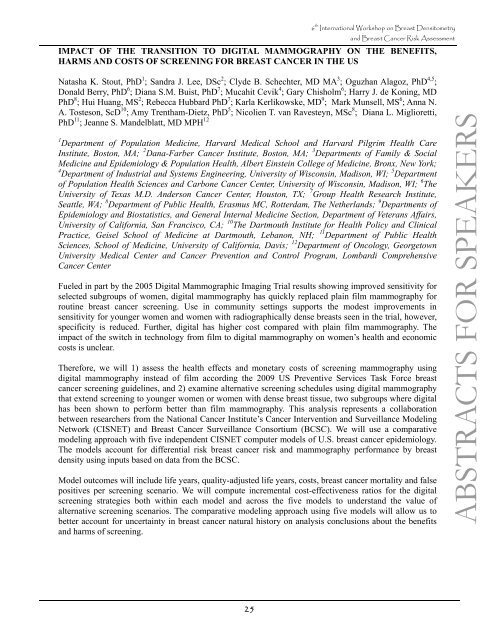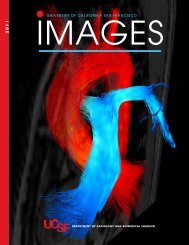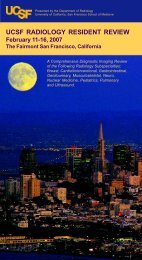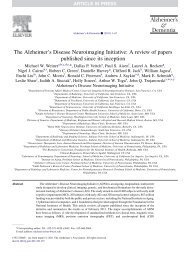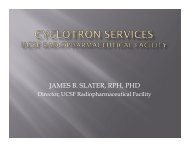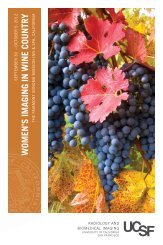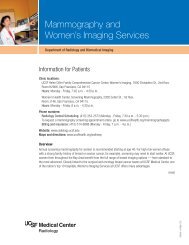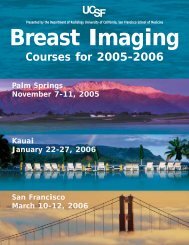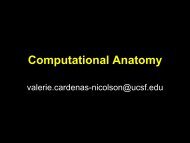6th International Workshop on Breast Densitometry and Breast ...
6th International Workshop on Breast Densitometry and Breast ...
6th International Workshop on Breast Densitometry and Breast ...
- No tags were found...
You also want an ePaper? Increase the reach of your titles
YUMPU automatically turns print PDFs into web optimized ePapers that Google loves.
6 th <str<strong>on</strong>g>Internati<strong>on</strong>al</str<strong>on</strong>g> <str<strong>on</strong>g>Workshop</str<strong>on</strong>g> <strong>on</strong> <strong>Breast</strong> <strong>Densitometry</strong><br />
<strong>and</strong> <strong>Breast</strong> Cancer Risk Assessment<br />
IMPACT OF THE TRANSITION TO DIGITAL MAMMOGRAPHY ON THE BENEFITS,<br />
HARMS AND COSTS OF SCREENING FOR BREAST CANCER IN THE US<br />
Natasha K. Stout, PhD 1 ; S<strong>and</strong>ra J. Lee, DSc 2 ; Clyde B. Schechter, MD MA 3 ; Oguzhan Alagoz, PhD 4,5 ;<br />
D<strong>on</strong>ald Berry, PhD 6 ; Diana S.M. Buist, PhD 7 ; Mucahit Cevik 4 ; Gary Chisholm 6 ; Harry J. de K<strong>on</strong>ing, MD<br />
PhD 8 ; Hui Huang, MS 2 ; Rebecca Hubbard PhD 7 ; Karla Kerlikowske, MD 9 ; Mark Munsell, MS 6 ; Anna N.<br />
A. Tostes<strong>on</strong>, ScD 10 ; Amy Trentham-Dietz, PhD 5 ; Nicolien T. van Ravesteyn, MSc 8 ; Diana L. Miglioretti,<br />
PhD 11 ; Jeanne S. M<strong>and</strong>elblatt, MD MPH 12<br />
1 Department of Populati<strong>on</strong> Medicine, Harvard Medical School <strong>and</strong> Harvard Pilgrim Health Care<br />
Institute, Bost<strong>on</strong>, MA; 2 Dana-Farber Cancer Institute, Bost<strong>on</strong>, MA; 3 Departments of Family & Social<br />
Medicine <strong>and</strong> Epidemiology & Populati<strong>on</strong> Health, Albert Einstein College of Medicine, Br<strong>on</strong>x, New York;<br />
4 Department of Industrial <strong>and</strong> Systems Engineering, University of Wisc<strong>on</strong>sin, Madis<strong>on</strong>, WI; 5 Department<br />
of Populati<strong>on</strong> Health Sciences <strong>and</strong> Carb<strong>on</strong>e Cancer Center, University of Wisc<strong>on</strong>sin, Madis<strong>on</strong>, WI; 6 The<br />
University of Texas M.D. Anders<strong>on</strong> Cancer Center, Houst<strong>on</strong>, TX; 7 Group Health Research Institute,<br />
Seattle, WA; 8 Department of Public Health, Erasmus MC, Rotterdam, The Netherl<strong>and</strong>s; 9 Departments of<br />
Epidemiology <strong>and</strong> Biostatistics, <strong>and</strong> General Internal Medicine Secti<strong>on</strong>, Department of Veterans Affairs,<br />
University of California, San Francisco, CA; 10 The Dartmouth Institute for Health Policy <strong>and</strong> Clinical<br />
Practice, Geisel School of Medicine at Dartmouth, Leban<strong>on</strong>, NH; 11 Department of Public Health<br />
Sciences, School of Medicine, University of California, Davis; 12 Department of Oncology, Georgetown<br />
University Medical Center <strong>and</strong> Cancer Preventi<strong>on</strong> <strong>and</strong> C<strong>on</strong>trol Program, Lombardi Comprehensive<br />
Cancer Center<br />
Fueled in part by the 2005 Digital Mammographic Imaging Trial results showing improved sensitivity for<br />
selected subgroups of women, digital mammography has quickly replaced plain film mammography for<br />
routine breast cancer screening. Use in community settings supports the modest improvements in<br />
sensitivity for younger women <strong>and</strong> women with radiographically dense breasts seen in the trial, however,<br />
specificity is reduced. Further, digital has higher cost compared with plain film mammography. The<br />
impact of the switch in technology from film to digital mammography <strong>on</strong> women’s health <strong>and</strong> ec<strong>on</strong>omic<br />
costs is unclear.<br />
Therefore, we will 1) assess the health effects <strong>and</strong> m<strong>on</strong>etary costs of screening mammography using<br />
digital mammography instead of film according the 2009 US Preventive Services Task Force breast<br />
cancer screening guidelines, <strong>and</strong> 2) examine alternative screening schedules using digital mammography<br />
that extend screening to younger women or women with dense breast tissue, two subgroups where digital<br />
has been shown to perform better than film mammography. This analysis represents a collaborati<strong>on</strong><br />
between researchers from the Nati<strong>on</strong>al Cancer Institute’s Cancer Interventi<strong>on</strong> <strong>and</strong> Surveillance Modeling<br />
Network (CISNET) <strong>and</strong> <strong>Breast</strong> Cancer Surveillance C<strong>on</strong>sortium (BCSC). We will use a comparative<br />
modeling approach with five independent CISNET computer models of U.S. breast cancer epidemiology.<br />
The models account for differential risk breast cancer risk <strong>and</strong> mammography performance by breast<br />
density using inputs based <strong>on</strong> data from the BCSC.<br />
Model outcomes will include life years, quality-adjusted life years, costs, breast cancer mortality <strong>and</strong> false<br />
positives per screening scenario. We will compute incremental cost-effectiveness ratios for the digital<br />
screening strategies both within each model <strong>and</strong> across the five models to underst<strong>and</strong> the value of<br />
alternative screening scenarios. The comparative modeling approach using five models will allow us to<br />
better account for uncertainty in breast cancer natural history <strong>on</strong> analysis c<strong>on</strong>clusi<strong>on</strong>s about the benefits<br />
<strong>and</strong> harms of screening.<br />
ABSTRACTS FOR SPEAKERS<br />
25


